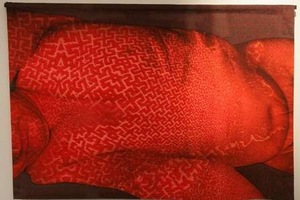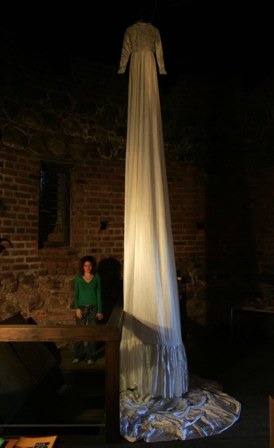DEATH OF TABOO 0
(Biennial of European contemporary art “Taboo or Not Taboo” in Kaunas) Kotryna Džilavjanaitė
www.kamane.lt, 2006 09 17
L.Oržekauskienė. "Body-drapery". Digital textile print. 2005
D.Robertson. "Tittal Kikks insid". Silk, installation. 2006
In brief: The 5th biennial of European contemporary art is wandering round Europe with the multi-sided topic “Taboo or Not Taboo”. Even though the exhibition is already off for Warsaw, it has left impressions which may be shared.
The supervisor of the project Bernard Calendini stressed that artists were encouraged “to disregard any taboos and to cross the limits and norms on the idea level, to visualise these trespasses and to reveal the visions and positions boldly”. Therefore, an interesting, inspiring and provoking topic has been offered to the creators and it was possible to anticipate a contrasting exposition which would receive applause or cause a wave of outrage.
However, even strengthened by the forces of art of several European countries, the exhibition of the biennial did not justify the intriguing and much promising name. Only half of the participants questioned the present or seeming taboos making one think about the border between the possible and the forbidden. Others only exhibited artworks which were more ore less successful and which did not suit to the revolutionary theme of the exhibition. Of course, we should not forget that taboos are not universal in the post-modern era. Nonetheless, dipping into the more general collective (sub)conscience, it is hard to find any works shocking by their form or content constructing new taboos or denying the old ones.
Vincent Ducarne (France) shocks by drastically exploiting animals in his video works “Labyrinth“ and “Team Film”. The Scottish artist Duncan Robertson reflects on the long-year traditions of the patriarchal society - he exhibits a giant wedding dress in Kaunas castle. Photographs shown on the walls reflect the dreams of the artist to get married in a white dress.
The Polis group SDS - Marek Sobczak and Bogdan Hildebrandt - say “no” to the mass cultural tourism (“Sacrum + Tourism“). The authors picture sacral places – graveyards, churches, ancient churches decorating them in bright colours in the series of photographs, thus, reminding about the heritage which is vanishing. Meanwhile, Jacek Staniszewski (Poland) expresses his discontent about the mass media in his work “Taboo or not Taboo” accusing it by the thrusting of violence and aggression. Looking at the works of the majority of foreigners, it becomes clear that they attempted to say something important or harsh but they were not very successful.
What about Lithuanians? Even though the concept of taboo is not very suitable talking about the exhibits of Laima Oržekauskienė, Vita Gelūnienė, Gintaras Česonis and Patricija Gilytė, one has to admit that the works are interesting and of high artistic quality.
L.Oržekauskienė and V.Gelūnienė interpret the picturing of naked body in their tapestries in an original manner. G. Česonis presents psychological and meaningful photographs where moments of daily life of Kaunas residents on the eve of turning into Europeans are captured. P.Gilytė presents the plastic video work “Heat 360°“ – one of the most interesting works of 2005. The question why artworks breaking no limits or taboos were selected for the exhibition of a particular topic remains open.










